History of Party
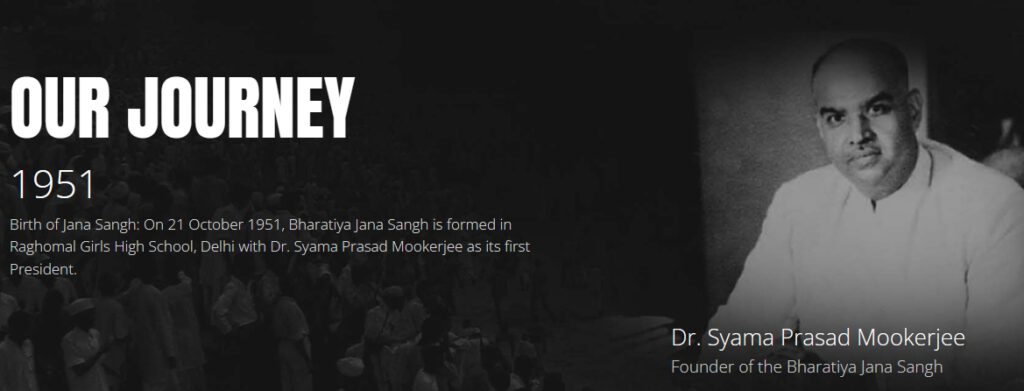
Birth of Jana Sangh: On 21 October 1951, Bharatiya Jana Sangh is formed in Raghomal Girls High School, Delhi with Dr. Syama Prasad Mookerjee as its first President.
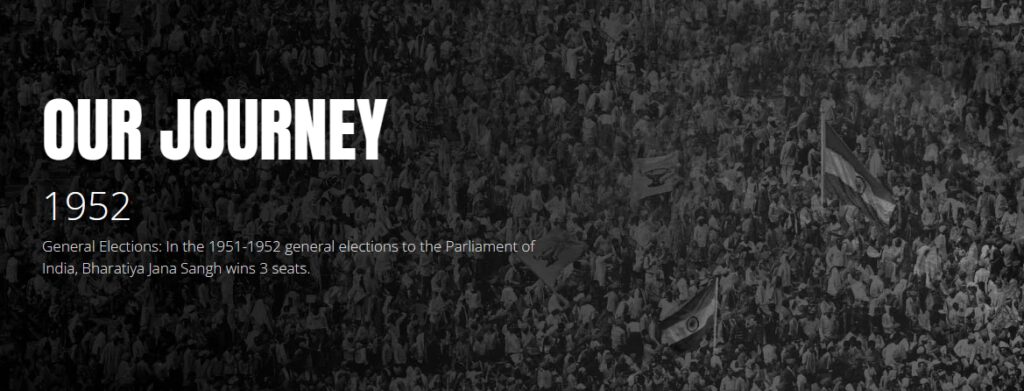
General Elections: In the 1951 -1952 general elections to the Parliament of India, Bharatiya Jana Sangh wins 3 seats.
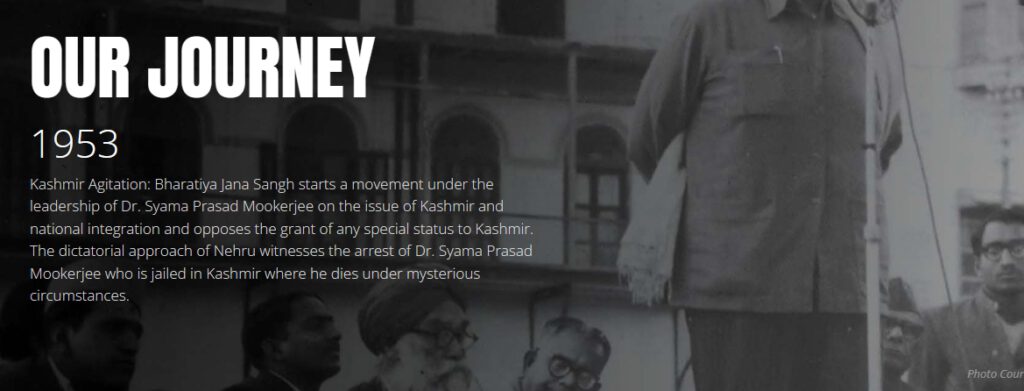
Kashmir Agitation: Bharatiya Jana Sangh starts a movement under the leadership of Dr. Syama Prasad Mookerjee on the issue of Kashmir and national integration and opposes the grant of any special status to Kashmir. The dictatorial approach of Nehru witnesses the arrest of Dr. Syama Prasad Mookerjee who is jailed in Kashmir where he dies under mysterious circumstances.
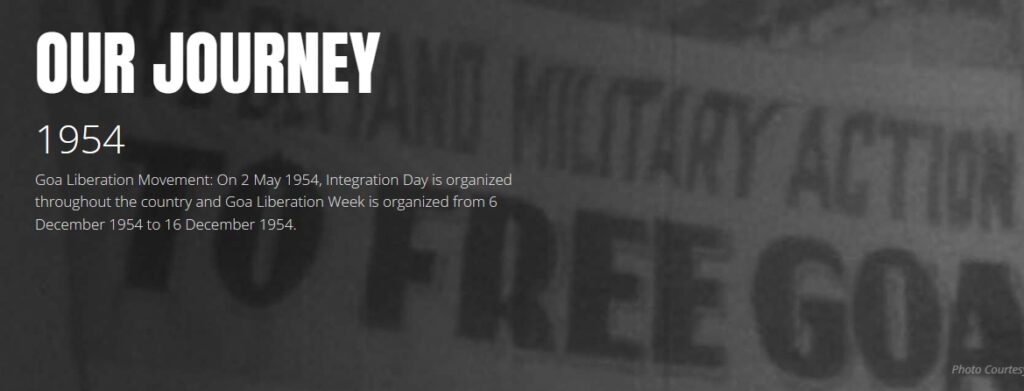
Goa Liberation Movement: On 2 May 1954, Integration Day is organized throughout the country and Goa Liberation Week is organized from 6 December 1954 to 16 December 1954.
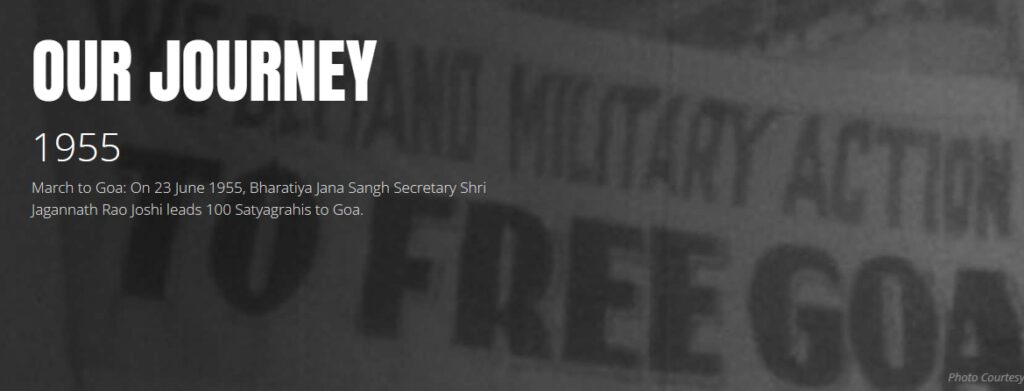
March to Goa: On 23 June 1955, Bharatiya Jana Sangh Secretary Shri Jagannath Rao joshi leads 100 Satyagrahis to Goa.
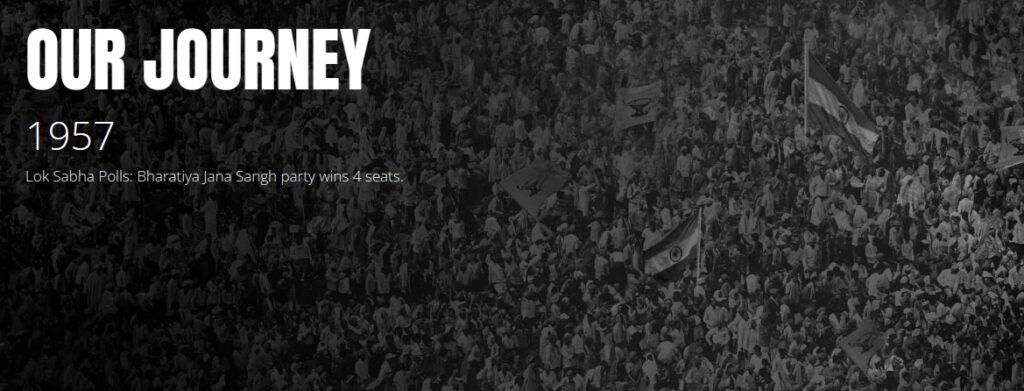
Lok Sabha Polls: Bharatiya Jana Sangh party wins 4 seats.
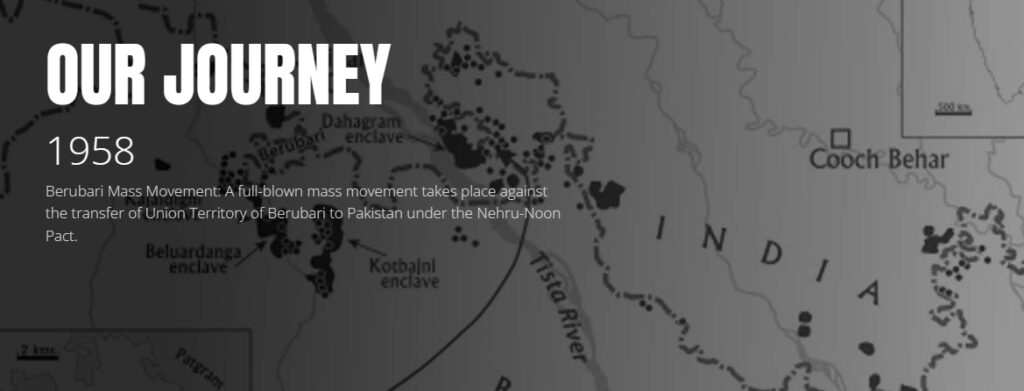
Berubari Mass Movement: A full-blown mass movement takes place against the transfer of Union Territory of Berubari to Pakistan under the Nehru-Noon
Pact

Lok Sabha Elections: Under the third Lok Sabha of India, Bharatiya Jana Sangh party resurges and comfortably wins 14 seats.

On 12 April 1964, Pandit Deendayal Upadhyaya ji and Dr. Ram Manohar Lohia ji issue a joint statement on Indo-Pak Federation and issue of minorities in India and Pakistan.

Lorem ipsum dolor sit amet, consectetur adipiscing elit, sed do eiusmod tempor incididunt ut labore et dolore magna aliqua. Ut enim aLok Sabha elections: Bharatiya Jana Sangh manages to win 22 seats despite populist announcements and promises by Congress under Indira Gandhi that help her win the elections.d minim veniam, quis nostrud exercitation ullamco laboris nisi ut aliquip ex ea commodo consequat.

Emergency: Indira Gandhi imposes emergency on 25 June 1975 that lasts till 3 March 1977. The glorious saga of struggle witnesses arrest and detainment of several Jana Sangh leaders and activists.
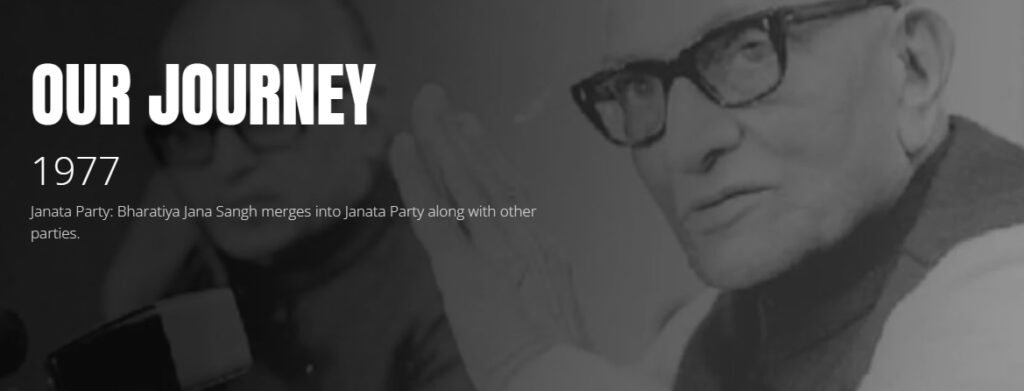
Janata Party: Bharatiya Jana Sangh merges into Janata Party along with other parties.

General Elections: The Janata Party is unable to make its mark as it wins just 31 seats. In April 1980, shortly after the elections, the National Executive Council of the Janata Party bans its members from being 'dual members' of party and the RSS. Consequently, the former jana Sangh members leave the Janata Party and float a new political party. Thus, the Bharatiya Janata Party comes into existence on 6 April 1980.

General Elections: The death of Indira Gandhi leads to early general elections in the country. Due to sympathy wave for the Congress party, BJP manages to win only 2 seats. After introspecting the result, BJP forms a high-powered Working Committee to recommend action for remedy and renewal.

Advani ji: Shri L.K. Advani takes charge as the party President for the first time in 1986 and continues till 1990.

Anti-corruption movement: A movement is launched against corruption in high places in the wake of Bofors Kickbacks.

General Elections: BJP substantially improves its position and wins 85 seats. The BJP and Commuists support the Janata Dal Government with VP Singh as the Prime Minister.
BJP supports the Ayodhya movement, the biggest mass movement in the history of independent India.
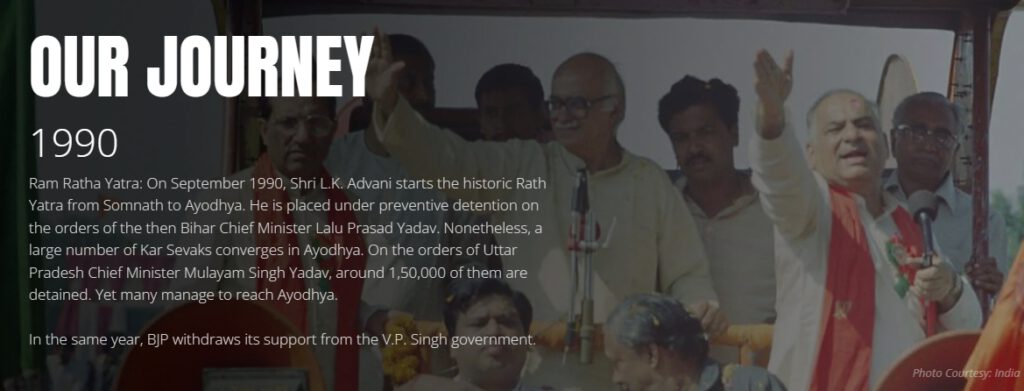
Ram Ratha Yatra: On September 1990, Shri L.K. Advani starts the historic Rath Yatra from Somnath to Ayodhya. He is placed under preventive detention on the orders of the then Bihar Chief Minister Lalu Prasad Yadav. Nonetheless, a large number of Kar Sevaks converges in Ayodhya. On the orders of Uttar Pradesh Chief Minister Mulayam Singh Yadav, around 1,50,000 of them are detained. Yet many manage to reach Ayodhya. In the same year, BJP withdraws its support from the V.P. Singh government.
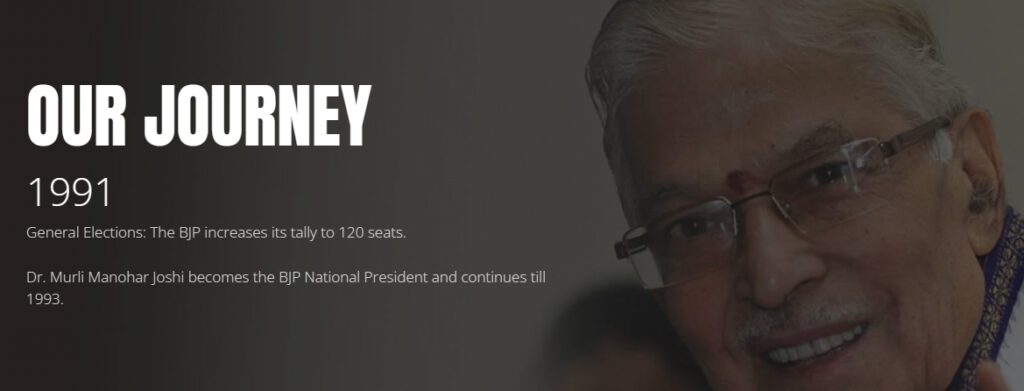
1991
General Elections: The BJP increases its tally to 120 seats.
Dr. Murli Manohar joshi becomes the BJP National President and continues till 1993.
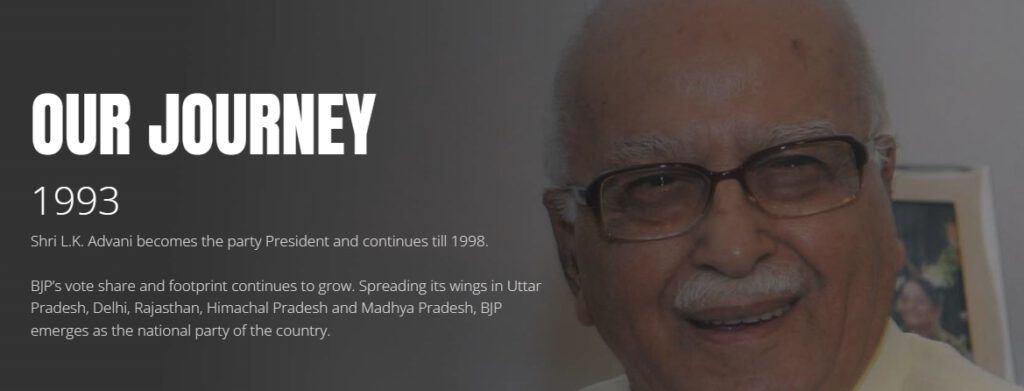
Shri L.K. Advani becomes the party President and continues till 1998.
BJP's vote share and footprint continues to grow. Spreading its wings in Uttar Pradesh, Delhi, Rajasthan, Himachal Pradesh and Madhya Pradesh, BJP emerges as the national party of the country.
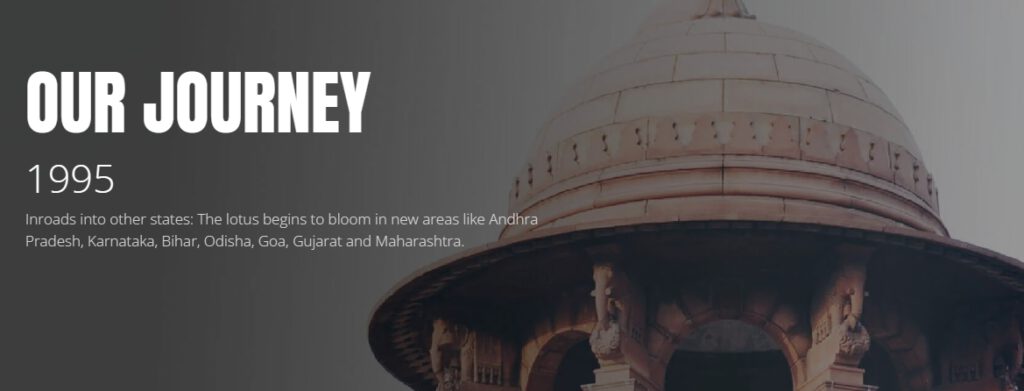
Inroads into other states: The lotus begins to bloom in new area: Pradesh, Karnataka, Bihar, Odisha, Goa, Gujarat and Maharashtra.

General Elections: BJP wins 161 Lok Sabha seats, becoming the largest party in the Parliament. Shri Atal Bihari Vajpayee is sworn in as the Prime Minister, but he's unable to attain a majority in the Lok Sabha, forcing the government to resign after 13 days. A coalition of regional parties led by janta Dal forms the government, but it doesn't last long forcing the country to go to mid-term polls in 1998.

General Elections: BJP contests the elections forming a coalition called the National Democratic Alliance (NDA). It comprises its existing allies like the Samata Party, the Shiromani Akali Dal, the Shiv Sena besides the All India Anna Dravida Munnetra Kazhagam (AIADMK)and the Biju Janata Dal. The NDA has a majority with outside support from the Telugu Desam Party (TDP) and Shri Vajpayee returns as the Prime Minister. However, the coalition ruptures in May 1999 when the leader of AIADMK withdraws her support, and fresh elections are held again.
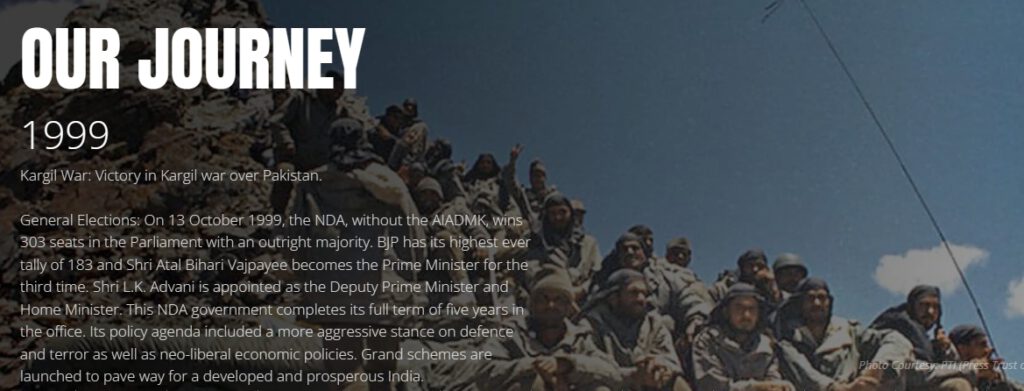
Kargil War: Victory in Kargil war over Pakistan.
General Elections: On 13 October 1999, the NDA, without the AIADMK, wins 303 seats in the Parliament with an outright majority. BJP has its highest ever tally of 183 and Shri Atal Bihari Vajpayee becomes the Prime Minister for the third time. Shri LK. Advani is appointed as the Deputy Prime Minister and Home Minister. This NDA government completes its full term of five years in the office. Its policy agenda included a more aggressive stance on defence and terror as well as neo-liberal economic policies. Grand schemes are launched to pave way for a developed and prosperous India.
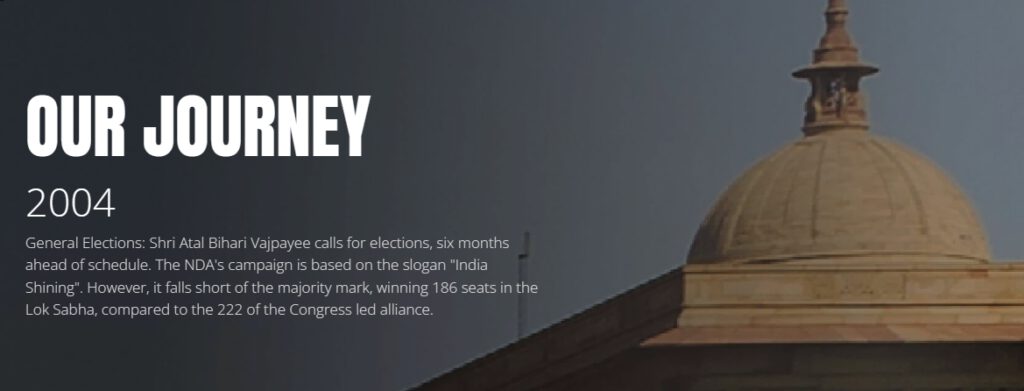
General Elections: Shri Atal Bihari Vajpayee calls for elections, six months ahead of schedule. The NDA's campaign is based on the slogan "India Shining". However, it falls short of the majority mark, winning 186 seats in the Lok Sabha, compared to the 222 of the Congress led alliance.

Karnataka assembly elections: In May, BJP wins the state elections in Karnataka. This is the first time that the party has won assembly elections,
gaining ground in any South Indian state.
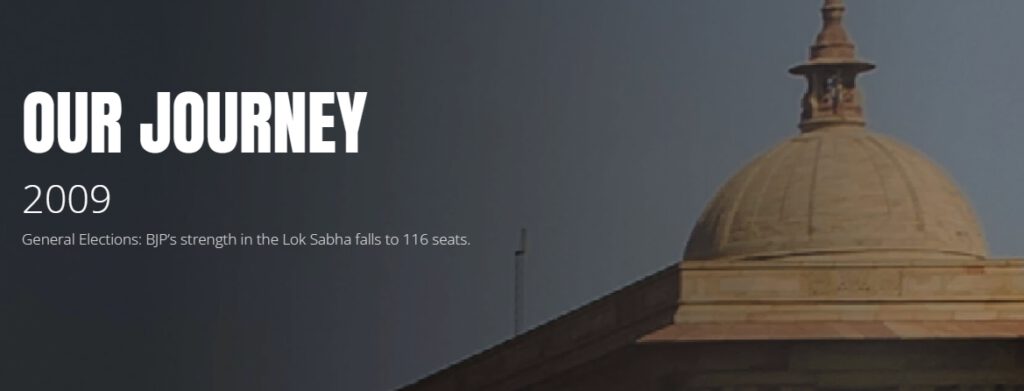
General Elections: BJP's strength in the Lok Sabha falls to 116 seats.
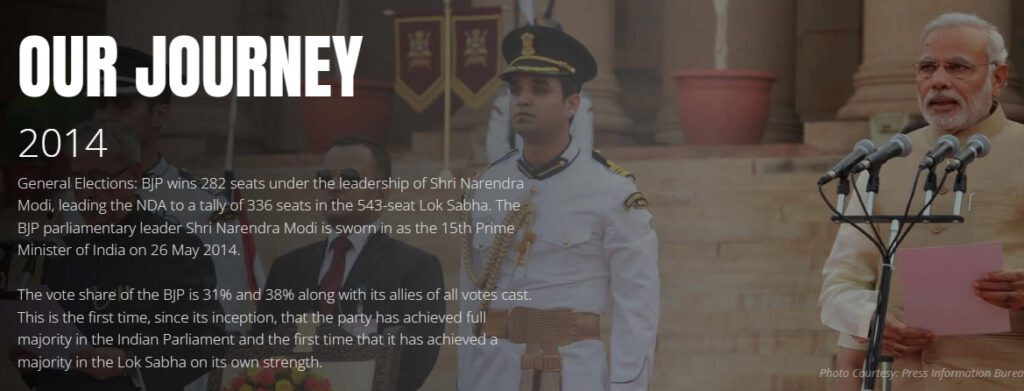
General Elections: BJP wins 282 seats under the leadership of Shri Narendra Modi, leading the NDA to a tally of 336 seats in the 543-seat Lok Sabha The BJP parliamentary leader Shri Narendra Modi is sworn in as the 15th Prime Minister of India on 26 May 2014.
The vote share of the BJP is 31% and 38% along with its allies of all votes cast This is the first time, since its inception, that the party has achieved full majority in the Indian Parliament and the first time that it has achieved a majority in the Lok Sabha on its own strength.
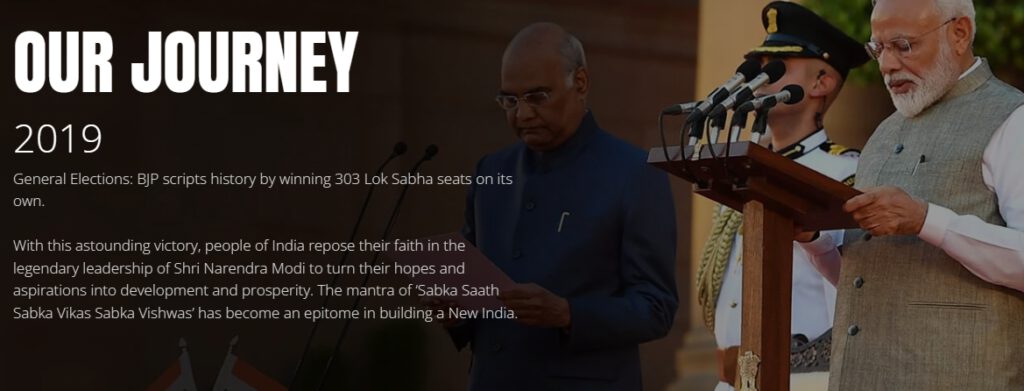
General Elections: BJP scripts history by winning 303 Lok Sabha seats on its
I With this astounding victory, people of India repose their faith in the legendary leadership of Shri Narendra Modi to turn their hopes and aspirations into development and prosperity. The mantra of 'Sabka Saath Sabka Vikas Sabka Vishwas' has become an epitome in building a New India.
